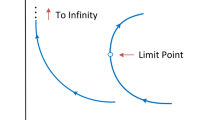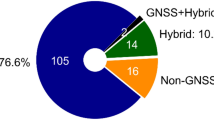Abstract
Incorporating quasi-periodic orbits into the preliminary design process offers a wide range of options to meet mission constraints and address the challenges in a complex trade space. In this investigation, linear stability and quasi-periodic orbit family continuation schemes are examined to meet various types of constraints. Applications in eclipse avoidance and transfer design are examined by leveraging quasi-periodic orbits and their associated hyperbolic manifolds in the lunar region. Solutions are transitioned to an ephemeris model to validate that geometries are maintained in higher-fidelity models. When the natural dynamical structures associated with quasi-periodic orbits are leveraged, novel trajectory solutions can emerge.
Similar content being viewed by others
Change history
11 February 2022
A Correction to this paper has been published: https://doi.org/10.1007/s42064-022-0136-2
References
Folta, D. C., Woodard, M., Howell, K., Patterson, C., Schlei, W. Applications of multi-body dynamical environments: The ARTEMIS transfer trajectory design. Acta Astronautica, 2012, 73: 237–249.
Folta, D. C., Pavlak, T. A., Haapala, A. F., Howell, K. C., Woodard, M. A. Earth-Moon libration point orbit stationkeeping: Theory, modeling, and operations. Acta Astronautica, 2014, 94(1): 421–433.
Roberts, C., Case, S., Reagoso, J., Webster, C. Early mission maneuver operations for the deep space climate observatory Sun-Earth L1 libration point mission. In: Proceedings of the AAS/AIAA Astrodynamics Specialist Conference, 2015: 2635–2654.
Dawn, T. F., Gutkowski, J., Batcha, A., Williams, J., Pedrotty, S. Trajectory design considerations for Exploration Mission 1. In: Proceedings of the 2018 Space Flight Mechanics Meeting, 2018: AIAA 2018-0968.
Information on https://www.nasa.gov/feature/deep-space-gateway-to-open-opportunities-for-distantdestinations (cited in 2017).
Davis, D., Boudad, K., Phillips, S., Howell, K. C. Disposal, deployment, and debris in near rectilinear halo orbits. In: Proceedings of the 29th AAS/AIAA Space Flight Mechanics Meeting, 2019: 865–884.
Farquhar, R. W., Kamel, A. A. Quasi-periodic orbits about the translunar libration point. Celestial Mechanics, 1973, 7(4): 458–473.
Richardson, D. L., Cary, N. D. A uniformly valid solution for motion about the interior libration point of the perturbed elliptic-restricted problem. In: Proceedings of the AAS/AIAA Astrodynamics Specialist Conference, 1975.
Gómez, G., Masdemont, J., Simó, C. Quasihalo orbits associated with libration points. The Journal of the Astronautical Sciences, 1998, 46(2): 135–176.
Gómez, G., Noguera, M. Some manifolds of periodic orbits in the restricted three-body problem. Celestial Mechanics, 1985, 35(3): 235–255.
Howell, K. C., Pernicka, H. J. Numerical determination of Lissajous trajectories in the restricted three-body problem. Celestial Mechanics, 1987, 41(1–4): 107–124.
Schilder, F., Osinga, H. M., Vogt, W. Continuation of quasi-periodic invariant tori. SIAM Journal on Applied Dynamical Systems, 2005, 4(3): 459–488.
Jorba, A., Olmedo, E. On the computation of reducible invariant tori on a parallel computer. SIAM Journal on Applied Dynamical Systems, 2009, 8(4): 1382–1404.
Gómez, G., Mondelo, J. M. The dynamics around the collinear equilibrium points of the RTBP. Physica D: Nonlinear Phenomena, 2001, 157(4): 283–321.
Olikara, Z. P., Scheeres, D. J. Numerical methods for computing quasi-periodic orbits and their stability in the circular restricted three-body problem. In: Proceedings of the IAA Conference on Dynamics and Control of Space Systems, 2012.
Olikara, Z. Computation of quasi-periodic tori and heteroclinic connections in astrodynamics using collocation techniques. Ph.D. Dissertation. Boulder, CO: Department of Aerospace Engineering Sciences, University of Colorado Boulder, 2016.
Baresi, N., Olikara, Z. P., Scheeres, D. J. Fully numerical methods for continuing families of quasi-periodic invariant tori in astrodynamics. The Journal of the Astronautical Sciences, 2018, 65(2): 157–182.
Haro, A., Canadell, M., Figueras, J. L., Luque, A., Mondelo, J. M. The Parameterization Method for Invariant Manifolds. Cham: Springer International Publishing, 2016.
Anderson, R. L., Easton, R. W., Lo, M. W. Computing libration point isolated invariant sets using isolating blocks. Physica D: Nonlinear Phenomena, 2020, 405: 132361.
Farquhar, R., Muhonen, D., Church, L. Trajectories and orbital maneuvers for the ISEE-3/ICE comet mission. In: Proceedings of the Astrodynamics Conference, 1984.
Roberts, C. E. Long term missions at the Sun-Earth libration point L1: ACE, WIND, and SOHO. In: Proceedings of the AAS/AIAA Astrodynamics Specialist Conference, 2011.
Restrepo, R. L., Russell, R. P., Lo, M. W. Europa lander trajectory design using Lissajous staging orbits. In: Proceedings of the AAS/AIAA Astrodynamics Specialist Conference, 2018.
Baresi, N., Scheeres, D. J. Quasi-periodic invariant tori of time-periodic dynamical systems: applications to small body exploration. In: Proceedings of the International Astronautical Congress, 2016.
Barden, B. T., Howell, K. C. Fundamental motions near collinear libration points and their transitions. The Journal of the Astronautical Sciences, 1998, 46(4): 361–378.
Baresi, N. Spacecraft formation flight on quasi-periodic invariant tori. Ph.D. Dissertation. Boulder, CO: Department of Aerospace Engineering Sciences, University of Colorado Boulder, 2017.
Henry, D. B., Scheeres, D. Generalized spacecraft formation design through exploitation of quasi-periodic tori families. In: Proceedings of the AIAA Scitech 2020 Forum, 2020: AIAA 2020-0950.
Guzzetti, D., Sood, R., Chappaz, L., Baoyin, H. X. Stationkeeping analysis for solar sailing the L4 region of binary asteroid systems. Journal of Guidance, Control, and Dynamics, 2019, 42(6): 1306–1318.
Szebehely V. The Theory of Orbits: The Restricted Problem of Three Bodies. New York: Academic Press, 1967.
Zimovan, E. M. Characteristics and design strategies for near rectilinear halo orbits within the Earth-Moon system. M.S. Thesis. West Lafayette, IN: School of Aeronautics and Astronautics, Purdue University, 2017.
Steves, B. A., Maciejewski, A. J., Hendry, M., Eds. Chaotic Worlds: from Order to Disorder in Gravitational N-body Dynamical Systems (Nato Science Series II: (277)). Springer, 2006.
Keller, H. B. Numerical Methods for Two-Point Boundary-Value Problems. Dover Publication, 1992.
Allgower, E. L., Georg, K. Introduction to Numerical Continuation Methods. New York: Springer, Berlin, Heidelberg, 1990.
Doedel, E. J., Romanov, V. A., Paffenroth, R. C., Keller, H. B., Dichmann, D. J., Galán-Vioque, J., Vanderbauwhede, A. Elemental periodic orbits associated with the libration points in the circular restricted 3-body problem. International Journal of Bifurcation and Chaos, 2007, 17(8): 2625–2677.
McCarthy, B. P. Characterization of quasi-periodic orbits for applications in the Sun-Earth and Earth-Moon Systems. M.S. Thesis. West Lafayette, IN: School of Aeronautics and Astronautics, Purdue University, 2018.
Bosanac, N. Bounded motions near resonant orbits in the Earth-Moon and Sun-Earth systems. In: Proceedings of the AAS/AIAA Astrodynamics Specialist Conference, 2018.
Jorba, À. Numerical computation of the normal behaviour of invariant curves of n-dimensional maps. Nonlinearity, 2001, 14(5): 943–976.
Information on https://naif.jpl.nasa.gov/naif/ (cited in 1996).
Bate, R. A., Mueller, D. D., White, J. E. Fundamentals of Astrodynamics. Dover Publications, 1971.
Vaquero, M., Howell, K. C. Leveraging resonant-orbit manifolds to design transfers between libration-point orbits. Journal of Guidance, Control, and Dynamics, 2014, 37(4): 1143–1157.
Hiday-Johnston, L. A., Howell, K. C. Impulsive time-free transfers between halo orbits. Celestial Mechanics and Dynamical Astronomy, 1996, 64(4): 281–303.
Haapala, A. F., Howell, K. C. A framework for constructing transfers linking periodic libration point orbits in the spatial circular restricted three-body problem. International Journal of Bifurcation and Chaos, 2016, 26(5): 1630013.
Capdevila, L. R., Howell, K. C. A transfer network linking Earth, Moon, and the triangular libration point regions in the Earth-Moon system. Advances in Space Research, 2018, 62(7): 1826–1852.
Das-Stuart, A., Howell, K. C., Folta, D. C. Rapid trajectory design in complex environments enabled by reinforcement learning and graph search strategies. Acta Astronautica, 2020, 171: 172–195.
Davis, D. C., Phillips, S. M., Howell, K.C., Vutukuri, S., McCarthy, B. P. Stationkeeping and transfer trajectory design for spacecraft in cislunar space. In: Proceedings of the AAS/AIAA Astrodynamics Specialist Conference, 2017.
Capdevila, L., Guzzetti, D., Howell, K. C. Various transfer options from Earth into distant retrograde orbits in the vicinity of the Moon. In: Proceedings of the AAS/AIAA Space Flight Mechanics Meeting, 2014.
McCarthy, B. P., Howell, K. C. Trajectory design using quasi-periodic orbits in the multi-body problem. In: Proceedings of the 29th AAS/AIAA Space Flight Mechanics Meeting, 2019.
Whitley, R., Martinez, R. Options for staging orbits in cislunar space. In: Proceedings of the IEEE Aerospace, 2015.
Whitley, R. J., Davis, D. C., Burke, L. M., McCarthy, B. P., Power, R. J., McGuire, M. J., Howell, K. C. Earth-Moon near rectilinear halo and butterfly orbits for lunar surface exploration. In: Proceedings of the AAS/AIAA Astrodynamics Specialist Conference, 2018.
Pavlak, T. Trajectory design and orbit maintenance strategies in multi-body dynamical regimes. Ph.D. Dissertation. West Lafayette, IN: School of Aeronautics and Astronautics, Purdue University, 2013.
Acknowledgments
The authors thank the Purdue University School of Aeronautics and Astronautics and the Rune and Barbara Eliasen Visualization Laboratory for the use of facilities and for financial support. The authors also thank the Purdue Multi-body Dynamics Research Group for insightful discussions about quasi-periodic orbits.
Author information
Authors and Affiliations
Corresponding author
Additional information
Brian McCarthy is currently a Ph.D. student in the School of Aeronautics and Astronautics at Purdue University. In 2014, he graduated from Virginia Tech with a double major in aerospace and ocean engineering and a minor in mathematics. After graduating from Virginia Tech, he worked for two years as a flight dynamics analyst on the Aqua, Aura, Terra, and TRMM missions at NASA Goddard Space Flight Center (GSFC). During his time at GSFC, he received a NASA Group Achievement Award for his efforts during decommissioning of the TRMM spacecraft. Brian began as a full-time graduate research assistant at Purdue University in the fall of 2016 and received his M.S. degree in December of 2018. His research area focuses on applying dynamical systems techniques to trajectory design in multi-body environments. He most recently worked with NASA Johnson Space Center on trajectory and mission design for the Lunar Gateway and Artemis programs.
Kathleen Howell is currently the Hsu Lo Distinguished Professor of Aeronautics and Astronautics in the College of Engineering at Purdue University. She earned her B.S. degree in aerospace engineering from Iowa State University. Her M.S. and Ph.D. degrees in aeronautical and astronautical Sciences are from Stanford University. Professor Howell’s technical research focus is astrodynamics in complex gravitational environments. She has successfully applied these methodologies to numerous NASA missions. Her contributions include mission planning and trajectory optimization, station-keeping and maneuver design, low-thrust applications that include small satellites, and the development of interactive visual capabilities for complex mission scenarios. As a principal investigator, she has obtained numerous grants and received various awards related to her research program and in recognition as an engineering educator. She served for many years as the Editor-in-Chief for the AAS Journal of the Astronautical Sciences; she is also a member of other editorial boards. Professor Howell is a member of the National Academy of Engineering, the American Academy of Arts and Sciences, the Celestial Mechanics Institute, and the International Academy of Astronautics. She is also a Fellow of both AIAA and AAS. She is involved with various other organizations within the international aerospace and astrodynamics community.
Rights and permissions
About this article
Cite this article
McCarthy, B.P., Howell, K.C. Leveraging quasi-periodic orbits for trajectory design in cislunar space. Astrodyn 5, 139–165 (2021). https://doi.org/10.1007/s42064-020-0094-5
Received:
Accepted:
Published:
Issue Date:
DOI: https://doi.org/10.1007/s42064-020-0094-5




